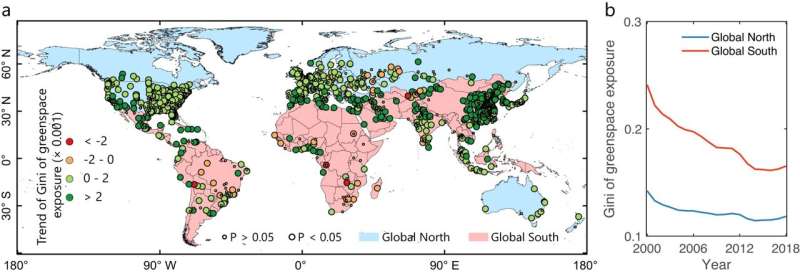This article has been reviewed according to Science X's editorial process and policies. Editors have highlighted the following attributes while ensuring the content's credibility:
fact-checked
peer-reviewed publication
trusted source
proofread
Scholars reveal improved human greenspace exposure equality during 21st century urbanization

More than half of the global population currently resides in urban settings, experiencing an influx of nearly 200,000 individuals each day. An increasing body of evidence highlights the significance of urban greenspaces, emphasizing their potential to boost psychological and physiological well-being, coupled with broader ecosystem service benefits. Consequently, ensuring universal access to public and greenspaces is vital for achieving sustainable and healthy development goals.
The evolution of cities has left a profound impact on greenspace exposure. In initial urban development stages, extensive built-up areas supplanted greenspaces. The subsequent rapid urban expansion led to the construction of significant artificial green landscapes, reshaping the nature of greenspace exposure in cities. However, the extent to which urbanization has affected human exposure to greenspace and related inequalities over time remains unclear.
Recent research conducted by researchers from The University of Hong Kong (HKU) in collaboration with colleagues from Tsinghua University has unveiled an improved human greenspace exposure equality among global large cities. This discovery underscores the positive impact of urbanization on the accessibility and benefits of greenspaces.
This research represents the first global exploration of human exposure to greenspace exposure and its associated equality shifts, focusing on the first two decades of the 21st century urbanization. The findings have been published in Nature Communications, providing valuable insights that can help inform future city greening efforts.
The research team developed a methodology incorporating 30-meter-resolution Landsat satellite time-series greenspace mapping and a population-weighted exposure framework to quantify the changes in human exposure to greenspace and associated equality from 2000 to 2018. The team examined 1,028 cities around the world and divided their sample into two main segments: Global South (developing countries) and Global North (developed countries) cities.
Global findings indicated a substantial increase in physical greenspace coverage and an improvement in human exposure to urban greenspace. This progress led to a marked reduction in greenspace exposure inequality over the past two decades. Nevertheless, there is a contrast in the rate of reduction in greenspace exposure inequality between cities in the Global South and North, with a much faster rate of reduction in the Global South, nearly four times that of the Global North.
Delving deeper into the underlying drivers, the researchers found that greenspace coverage, as a measurement of greenspace supply, has dominantly promoted the improvement in the temporal change of greenspace exposure inequality.
Dr. Bin Chen, the project's principal investigator and Assistant Professor of Division of Landscape Architecture at HKU said, "This study is a timely thrust on our earlier work published in Nature Communications, which highlighted contrasting greenspace exposure inequalities between cities of the Global North and Global South. The current research offers a comprehensive, longitudinal view of how this exposure and its associated inequalities have evolved over time."
Dr. Chen emphasized two important contributions from this study. The research findings reveal a trend toward equality in human exposure to greenspace, as reflected by a decline in inequality indices such as Gini, Atkinson, and Theil coefficients. Another key insight is that this study observes prominent spatial differences in urban greenspace trends in the contrast between Global North and Global South cities.
Dr. Chen said, "These findings provide encouraging evidence, showcasing that cities globally are making positive progress in realizing the 11th sustainable development goal."
"The study tells a broadly positive story of the opening decades of the urban century, and our analysis of trends, and subsequent studies of positive outliers in those trends, will help cities achieve better net outcomes when planning for balanced changes in urban greenspace loss and construction by incorporating multidimensional contexts of greening history, greenspace supply status quo, prioritized vulnerable hotspots and the underlying socio-economic factors," said Professor Chris Webster, chair professor of urban planning and development economics, dean of Faculty of Architecture, HKU.
Adding to the discourse, Professor Peng Gong, chair professor of global sustainability at Department of Geography and Department of Earth Sciences, Vice-President and Pro-Vice-Chancellor (Academic Development) of HKU, said, "This research is timely and offers invaluable insights, serving as a beacon for government bodies, urban planners, and private sector developers. It emphasizes the adoption of comprehensive urban strategies to not only increase but also enhance the quality of greenspaces, all in pursuit of the sustainable development goals."
More information: Shengbiao Wu et al, Improved human greenspace exposure equality during 21st century urbanization, Nature Communications (2023). DOI: 10.1038/s41467-023-41620-z
Journal information: Nature Communications
Provided by The University of Hong Kong




















